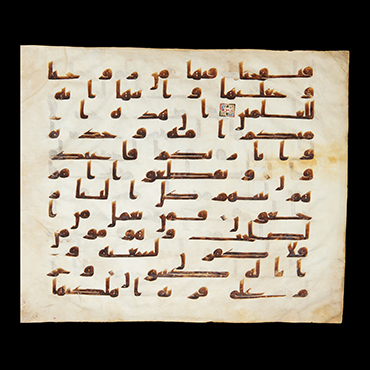A Folio from a Monumental Qur’an
This folio is from a colossal manuscript known as the Tashkent Qur’an, named after the city in Uzbekistan where the largest surviving portion is kept. Likely made in the central Islamic lands during the 2nd century AH /8th century CE, it later traveled to Central Asia in the medieval period. The Tashkent Qur’an is one of the oldest surviving Qur’an manuscripts in existence, written in an early version of the kufic script. It is exceptionally large and uses sheets of prepared animal skins, which would have been very costly. Its age and size make it one of the most important of all surviving early Qur’an manuscripts.
The importance of the Holy Qur’an in Islam led to the preeminent position of writing among all the arts of the early Islamic period. This art was developed and expressed to its greatest effect in architectural inscriptions, on coins, and in Qur’an manuscripts. In the late 1st to early 2nd century AH/late 7th to early 8th century CE, the letters used by previous generations were transformed into a formal calligraphic script now known as kufic, which could be both monumental and majestic.
Although it was originally suggested that this copy of the Qur’an was produced under the Rashidun caliph ‘Uthman bin Affan (r. AH 23–36/644–56 CE), more recent scholarship has attributed production of the Tashkent Qur’an to either the Umayyad or early Abbasid dynasties. Whatever the precise dating, the manuscript from which this folio originally came was designed not only to glorify the Holy Qur’an, but also to magnify the caliphate and the dynasty that commissioned and displayed it, no doubt in one of the key congregational mosques. It can therefore be seen both as an expression of the power of Islam and as an imperial statement of the greatest importance.
Folio from the Tashkent Qur’an
Near East, possibly Syria, 2nd century AH/8th century CE
Parchment, ink, opaque pigments, h. 55.8 × w. 70 cm
The Al Thani Collection, ATC673

